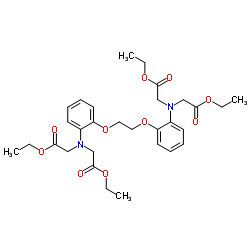BAPTA
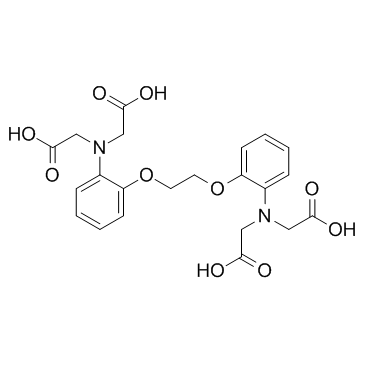
BAPTA structure
|
Common Name | BAPTA | ||
|---|---|---|---|---|
| CAS Number | 85233-19-8 | Molecular Weight | 476.433 | |
| Density | 1.5±0.1 g/cm3 | Boiling Point | 766.6±60.0 °C at 760 mmHg | |
| Molecular Formula | C22H24N2O10 | Melting Point | 177-179 °C | |
| MSDS | USA | Flash Point | 417.4±32.9 °C | |
| Symbol |

GHS07 |
Signal Word | Warning | |
Use of BAPTABAPTA is a specific chelator of Ca2+, suppresses intracellular reactive oxygen species (ROS) levels. |
| Name | bapta |
|---|---|
| Synonym | More Synonyms |
| Description | BAPTA is a specific chelator of Ca2+, suppresses intracellular reactive oxygen species (ROS) levels. |
|---|---|
| Related Catalog | |
| Target |
Ca2+ chelator[1] |
| In Vitro | Regarding ROS generation, a Ca2+ specific chelator, BAPTA, suppresses ROS generation of Sodium lauryl sulfate (SLS)-exposed HaCaT keratinocytes[1]. Depolarization does not increase the resting open probability of the mechanoelectrical transducer (MET) current of Tmc1Bth/Bth OHCs, whereas raising the intracellular concentration of the Ca2+ chelator BAPTA causes smaller increases in resting open probability in Bthmutant outer hair cells (OHCs) than in wild-type control cells. In the presence of 0.1 mM BAPTA, nonsaturating bundle displacements causes the MET current to adapt in both genotypes, exactly as seen when 1 mM EGTA is used in the intracellular solution. In the presence of 10 mM intracellular BAPTA, the time-dependent MET current decline is abolished and the resting Popen increased to near 50% of the maximal MET current in OHCs from both Tmc1+/+ and Tmc1Bth/Bth mice. The relation between the MET current and bundle displacement shows that increasing the intracellular BAPTA concentration from 0.1 to 10 mM significantly increased (p<0.0001) the resting Popen of the MET current in both Tmc1+/+ (0.1 mM, 8±1.6%, n=4; 10 mM, 39.6±2.7%, n=5) and Tmc1Bth/Bth (0.1 mM, 10.4±2.2%, n=3; 10 mM, 46.5±9.9%, n=6). No significant differences are seen between the two genotypes for both BAPTA concentrations. However, 3 and 5 mM BAPTA are less effective in shifting the MET current-bundle displacement curves in Tmc1Bth/Bth than in Tmc1+/+ OHCs. In Tmc1+/+, increasing the BAPTA concentration from 0.1 mM to either 3 or 5 mM produces a highly significant increase in Popen (post hoc test from one-way ANOVA, p<0.01 and p<0.001, respectively); in Tmc1Bth/Bth, the same comparison produced no or a much reduced increase in Popen (n.s. and p<0.05, respectively)[2]. |
| References |
| Density | 1.5±0.1 g/cm3 |
|---|---|
| Boiling Point | 766.6±60.0 °C at 760 mmHg |
| Melting Point | 177-179 °C |
| Molecular Formula | C22H24N2O10 |
| Molecular Weight | 476.433 |
| Flash Point | 417.4±32.9 °C |
| Exact Mass | 476.143097 |
| PSA | 174.14000 |
| LogP | 0.13 |
| Vapour Pressure | 0.0±2.7 mmHg at 25°C |
| Index of Refraction | 1.657 |
| InChIKey | FTEDXVNDVHYDQW-UHFFFAOYSA-N |
| SMILES | O=C(O)CN(CC(=O)O)c1ccccc1OCCOc1ccccc1N(CC(=O)O)CC(=O)O |
| Storage condition | 2-8°C |
| Symbol |

GHS07 |
|---|---|
| Signal Word | Warning |
| Hazard Statements | H315-H319-H335 |
| Precautionary Statements | P261-P305 + P351 + P338 |
| Personal Protective Equipment | dust mask type N95 (US);Eyeshields;Gloves |
| Hazard Codes | Xi: Irritant; |
| Risk Phrases | 36/37/38 |
| Safety Phrases | S26-S36 |
| RIDADR | NONH for all modes of transport |
| WGK Germany | 3 |
|
~% 
BAPTA CAS#:85233-19-8 |
| Literature: Bulletin des Societes Chimiques Belges, , vol. 103, # 7-8 p. 309 - 320 |
|
~% 
BAPTA CAS#:85233-19-8 |
| Literature: Bulletin des Societes Chimiques Belges, , vol. 103, # 7-8 p. 309 - 320 |
|
~% 
BAPTA CAS#:85233-19-8 |
| Literature: Bulletin des Societes Chimiques Belges, , vol. 103, # 7-8 p. 309 - 320 |
|
~% 
BAPTA CAS#:85233-19-8 |
| Literature: Bulletin des Societes Chimiques Belges, , vol. 103, # 7-8 p. 309 - 320 |
|
~% 
BAPTA CAS#:85233-19-8 |
| Literature: Bulletin des Societes Chimiques Belges, , vol. 103, # 7-8 p. 309 - 320 |
|
The Ca²⁺-calmodulin-Ca²⁺/calmodulin-dependent protein kinase II signaling pathway is involved in oxidative stress-induced mitochondrial permeability transition and apoptosis in isolated rat hepatocytes.
Arch. Toxicol. 88(9) , 1695-709, (2014) Oxidative stress (OS) is a common event in most hepatopathies, leading to mitochondrial permeability transition pore (MPTP) formation and further exacerbation of both OS from mitochondrial origin and ... |
|
|
Activation of epidermal growth factor receptor is required for Chlamydia trachomatis development.
BMC Microbiol. 14 , 277, (2015) Chlamydia trachomatis (C. trachomatis) is a clinically significant human pathogen and one of the leading causative agents of sexually transmitted diseases. As obligate intracellular bacteria, C. trach... |
|
|
HD iPSC-derived neural progenitors accumulate in culture and are susceptible to BDNF withdrawal due to glutamate toxicity.
Hum. Mol. Genet. 24 , 3257-71, (2015) Huntington's disease (HD) is a fatal neurodegenerative disease, caused by expansion of polyglutamine repeats in the Huntingtin gene, with longer expansions leading to earlier ages of onset. The HD iPS... |
| 2,2',2'',2'''-[ethane-1,2-diylbis(oxybenzene-2,1-diylnitrilo)]tetraacetic acid |
| N,N'-[1,2-Ethanediylbis(oxy-2,1-phenylene)]bis[N-(carboxymethyl)glycine] |
| 1,2-Bis(o-aminophenoxy)ethane-N,N,N',N'-tetraacetic acid |
| 1,2-Bis(2-aminophenoxy)ethane-N,N,N′,N′-tetraacetic acid |
| MFCD00036255 |
| Bapeta |
| 2-[2-[2-[2-[bis(carboxymethyl)amino]phenoxy]ethoxy]-N-(carboxymethyl)anilino]acetic acid |
| 1,2-bis-(2-amino-phenoxy)ethane N,N,N',N'-tetraacetic acid |
| 5F-Bapta |
| 2,2',2'',2'''-[1,2-Ethanediylbis(oxy-2,1-phenylenenitrilo)]tetraacetic acid |
| 2,2',2'',2'''-[Ethane-1,2-diylbis(oxy-2,1-phenylenenitrilo)]tetraacetic acid |
| 1,2-Bis(2-aminophenoxy)ethane-N,N,N',N'-tetraacetic acid |
| BAPTA |
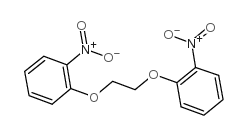
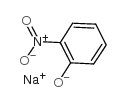
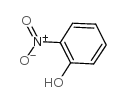
![2,2'-[1,2-Ethanediylbis(oxy)]dianiline structure](https://image.chemsrc.com/caspic/110/52411-34-4.png)
